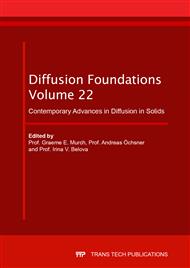[1]
ASM Metals Handbook 2nd Edition. Ed. J.R. Davis, Davis and Associates. ASM International: Materials Park, Ohio. (1998), p.54, 1030-1031.
Google Scholar
[2]
Metals Handbook, vol.10: Failure Analysis and Prevention: 8th edition. American Society for Metals: Ohio. (1975), p.129, 561.
Google Scholar
[3]
Abhay K. Jha, Satish Kumar Singh, M. Swathi Kiranmayee, P.P. Sinha. Failure Analysis of Titanium Alloy (Ti6Al4V) Fastener Used in Aerospace Application. Engineering Failure Analysis (2010), 17: 1457-1465.
DOI: 10.1016/j.engfailanal.2010.05.007
Google Scholar
[4]
Vartha Venkateswarlu, Debashish Tripathy, K. Rajagopal, K. Thomas Tharian, P.V. Venkitakrishnan. Failure analysis and optimization of thermo-mechanical process parameters of titanium alloy (Ti-6Al-4V) fasteners for aerospace applications. Case Studies in Engineering Failure Analysis (2013), 1:49-60.
DOI: 10.1016/j.csefa.2013.04.003
Google Scholar
[5]
Congressional Record- Senate (2003). Government Printing Office. p.18506, July 17, (2003).
Google Scholar
[6]
Information Release, Department of Defense Office of the Inspector General, Accessed 1 October 2010. http://www.dodig.mil/IGInformation/IGInformationReleases/ Temperform_Plea_092704.pdf, published 27 September (2004).
Google Scholar
[7]
Nayan, Niraj, SVS Narayana Murty, Abhay K. Jha, Bhanu Pant, S. C. Sharma, Koshy M. George, and G. V. S. Sastry. Processing and characterization of Al–Cu–Li alloy AA2195 undergoing scale up production through the vacuum induction melting technique., Materials Science and Engineering: A 576 (2013): 21-28.
DOI: 10.1016/j.msea.2013.03.054
Google Scholar
[8]
Hekmat-Ardakan, A., E. M. Elgallad, F. Ajersch, and X-G. Chen. Microstructural evolution and mechanical properties of as-cast and T6-treated AA2195 DC cast alloy., Materials Science and Engineering: A 558 (2012): 76-81.
DOI: 10.1016/j.msea.2012.07.075
Google Scholar
[9]
Wang, Liang, Min Hao, Guoai Li, and Gaohong Chen. In-situ Investigation of the Fracture Behaviors of 2195-T8 Aluminum-Lithium alloy., In MATEC Web of Conferences, vol. 67, p.05028. EDP Sciences, (2016).
DOI: 10.1051/matecconf/20166705028
Google Scholar
[10]
Nayan, Niraj, SVS Narayana Murty, Abhay K. Jha, Bhanu Pant, S. C. Sharma, Koshy M. George, and G. V. S. Sastry. Mechanical properties of aluminium–copper–lithium alloy AA2195 at cryogenic temperatures., Materials and Design 58 (2014): 445-450.
DOI: 10.1016/j.matdes.2014.02.024
Google Scholar
[11]
El-Aty, Ali Abd, Yong Xu, Xunzhong Guo, Shihong Zhang, Yan Ma, and Dayong Chen. Strengthening mechanisms, deformation behavior, and anisotropic mechanical properties of Al-Li alloys: A review., Journal of Advanced Research (2017).
DOI: 10.1016/j.jare.2017.12.004
Google Scholar
[12]
Nayan, Niraj, Nilesh P. Gurao, SVS Narayana Murty, Abhay K. Jha, Bhanu Pant, S. C. Sharma, and Koshy M. George. Microstructure and micro-texture evolution during large strain deformation of an aluminium–copper–lithium alloy AA 2195., Materials and Design (1980-2015) 65 (2015): 862-868.
DOI: 10.1016/j.matdes.2014.09.037
Google Scholar
[13]
Yang, Qingbo, Xinzhu Wang, Xu Li, Zanhui Deng, Zhihong Jia, Zhiqing Zhang, Guangjie Huang, and Qing Liu. Hot deformation behavior and microstructure of AA2195 alloy under plane strain compression., Materials Characterization131 (2017): 500-507.
DOI: 10.1016/j.matchar.2017.06.001
Google Scholar
[14]
W.M. Johnston, W.D. Pollock, and D.S. Dawicke. 'Biaxial Testing of 2195 Aluminum Lithium Alloy Using Cruciform Specimens,', NASA, (2002), 211942.
Google Scholar
[15]
M.L. Bairwa, S..G. Desai, and P.P. Date, Identification of Heat Treatments for Better Formability in an Aluminum-Lithium Alloy Sheet, JMEPEG, (2005), 14, p.623–633.
DOI: 10.1361/105994905x64503
Google Scholar
[16]
R. Rioja, Fabrication Methods to Manufacture Isotropic Al-Li Alloys and Products for Space and Aerospace Applications, Mater. Sci. Eng., (1998), A257, p.100–107.
DOI: 10.1016/s0921-5093(98)00827-2
Google Scholar
[17]
N.J. Kim and E.W. Lee, Effect of T1 Precipitate on the Anisotropy of Al-Li Alloy 2090, Acta Metall. Mater., (1993), 41, p.941.
DOI: 10.1016/0956-7151(93)90028-q
Google Scholar
[18]
O.S. Es-Said and E.W. Lee, The Effect Of Stretch Orientation (and Rolling Mode) on the Tensile Behavior of 2095 Aluminum-Lithium Alloy, Light Weight Alloys for Aerospace Applications III, E.W. Lee, K.V. Jata, W.E. Frazier, N.J. Kim, Ed., TMS, (1995), p.57–64.
Google Scholar
[19]
E.W. Lee, P.N. Kalu, L. Brandao, O.S. Es-Said, J. Foyos, and H. Garmestani, The Effect of Off-Axis Thermo-Mechanical Processing on the Mechanical Behavior of Textured 2095 Al-Li Alloy, Mater. Sci. Eng., (1999), A265, p.100–109.
DOI: 10.1016/s0921-5093(98)01150-2
Google Scholar
[20]
O.S. Es-Said, CJ Parrish, C.A. Bradberry, J.Y. Hassoun, R.A. Parish, A. Nash, N.C. Smythe, K.N. Tran, T. Ruperto, E.W. Lee, D. Mitchell, and C. Vinquist, Effect of Stretch Orientation and Rolling Orientation on the Mechanical Properties of 2195 Al-Cu-Li Alloy, Journal of Materials Engineering and Performance, Published online 26 August (2010).
DOI: 10.1007/s11665-010-9746-6
Google Scholar
[21]
MatWeb—The Online Materials Information Resource" Online Materials Information Resource---MatWeb. Web. 18 October 2010, http://www.matweb.co2m/search/DataSheet.aspx, MatGUID=4363dafc7f5545688506d8b4af1e9468&ckck=1.
Google Scholar
[22]
ASTM E8 / E8M-09, Standard Test Methods for Tension Testing of Metallic Materials, ASTM International, West Conshohocken, PA, (2009), www.astm.org.
DOI: 10.1520/jte20190549
Google Scholar
[23]
J.K. Holmen, J. Johnson, S. Jupp, O.S. Hopperstad, T. Borvik. Effects of heat treatment on the ballistic properties of AA6070 aluminum alloy. International Journal of Impact Engineering (2013), 57: 119-133.
DOI: 10.1016/j.ijimpeng.2013.02.002
Google Scholar
[24]
O. Klein, I. Baker. Effect of Heat-Treatment on the Tensile Behavior of Iron-Rich FeAl and FeAl+B. Scripts Metallurgica et Materialia (1994), 30: 627-632.
DOI: 10.1016/0956-716x(94)90441-3
Google Scholar
[25]
S. Al-Sulaiman, A. Al-Shamari, S.S. Prakash, A. Al-Mithin, M. Islam, S.G. Al-Karim. Premature failure of a Nickel Aluminum Bronze vacuum pump in seawater service. NACE Corrosion Conference & Expo (2009), Paper No.09200: 1-7.
DOI: 10.2118/164190-ms
Google Scholar


